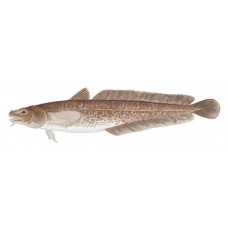Latin name
Lota lota
Other names
Eelpout, pout, ling, cusk, lawyer, lingcod, gudgeon, freshwater ling, mud blower, lush (Alaska), maria (Canada); French: lotte, lotte de riviére; Spanish: lota.
Identification
The head is flattened, broad, with an unpaired antenna on the chin and short antennae at the nostrils. The scales are fine, immersed in the skin. Lateral line continuous up to the end of the anal fin, then interrupted. The mouth is large, terminal, with numerous small, bristle-shaped teeth on the jaws and cuspidor. The elongated shape resembles an eel or something in between an eel and a catfish. It also resembles a smaller and thinner version of the saltwater cod. Other distinguishing features include tubular nostrils, one chin barb, and a rounded tail. The fins with soft rays are also noteworthy. The pectoral fins are large and rounded, the first dorsal fin is small and short, and the second dorsal and anal fins start near the middle of the body and continue to the tail. It has a wide head, small eyes, and small, embedded scales that create a smooth skin. Burbot has a mottled appearance due to a dark brown or black pattern scattered over a yellow, light brown, or tan background. Regional variations in color are possible, including light brown, dark brown, dark olive, or even yellow. The anal fins have a dark edge.
Distribution
Burbot is widespread throughout the circumpolar region above 40°N, especially in Alaska, Canada, the northern United States (including the Missouri and Ohio River drainages), and in some parts of Europe. It is absent in Scotland, Ireland, the Kamchatka Peninsula, the west coast of Norway, the far west of British Columbia, Nova Scotia, and the Atlantic Islands. In the Far East, it is found in the basin of the Amur, in the upper reaches of the Yalu and Sakhalin, and rarely in the estuaries of the Don, Volga, Dnepr, and Dniester.
Habitat
Freshwater river fish. It lives both at shallow depths and at quite considerable depths (up to 230 m). Burbot likes cold and clear water. At water temperatures above 15 °C falls into a torpor, but when it rises to 25 °C, there were cases of mass death of fish. In autumn, it comes to shores, forming feeding and later spawning aggregations. Dwelling in large, deep, cold rivers and lakes, burbot are found in depths of almost 700 feet. They live in deep water during the summer and move to shallower waters during the summer nights.
Size
Adult fish average 15 inches in length and weigh less than a pound. Fish caught by anglers usually weigh a few pounds and sometimes reach 8 pounds, although they can grow much larger. The world record of 18 pounds 11 ounces belongs to a fish caught on all tackle, but larger specimens have been caught in Alaska, at least one of them reaching nearly 60 pounds. Linear growth varies from body of water to body of water. Reaches sexual maturity in the 3rd-4th year of life. Some may live as long as 20 years.
Life history and Behavior
By age 3, burbot become sexually mature. It is one of the few species that spawns in mid- to late winter under the ice, doing so at night in shallow bays 1 to 4 feet deep over sand or gravel. It sometimes spawns in rivers 1 to 10 feet deep. It can produce more than a million spherical amber eggs at a time, although the average number is half that number. Without a nest or parental protection, the eggs hatch in four to five weeks.
Food and feeding habits
In the first years of life, it feeds exclusively on invertebrates. Young individuals feed on plankton and insects, gradually transitioning to a diet consisting almost entirely of fish, especially perch and whitefish. They also eat clams, fish eggs, plankton, and crustaceans. By eating the eggs of valuable commercial fish, the burbot is damaging the natural reproduction of these fish. Stones and other indigestible objects have been found in their stomachs.
Reproduction
Spawning lasts a month or more and takes place under the ice. It can go upstream to several hundred kilometers for spawning. Fecundity varies from 80-100 thousand eggs to 1 million and more. The egg structure is similar to that of pelagophilic fish. Owing to the presence of a fatty drop, it is suspended in the bottom layers of water. The incubation period lasts up to 3–4 months. The larvae usually hatch just before the rivers open up.
Interesting facts
The cold-loving burbot crawls into burrows under washed-out banks on hot summer days when the water gets too warm, and goes into torpor.
| Classification | |
| Phylum | Chordata |
| Class | Actinopterygii |
| Squad | Gadiformes |
| Family | Lotidae |
| Genus | Lota |
| Species | L. lota |
| Features | |
| Conservation status | Least Concern |
| Habitat | Bottom |
| Life span, years | 20 |
| Maximum body weight, kg | 12 |
| Maximum length, cm | 120 |
| Sailing speed, m/s | No information |
| Threat to people | Edible |
| Way of eating | Predator |
Burbot
Tags: Burbot




